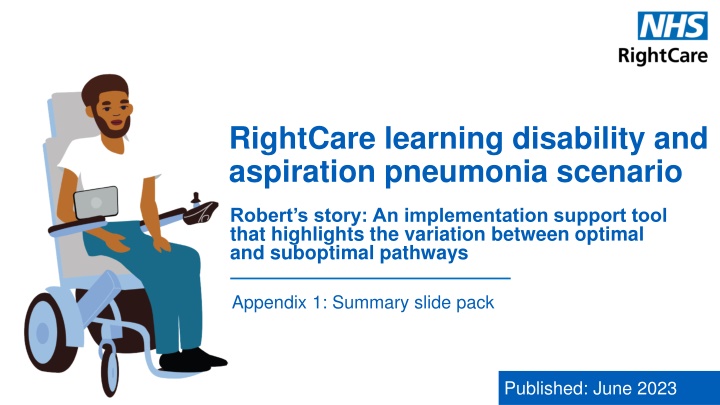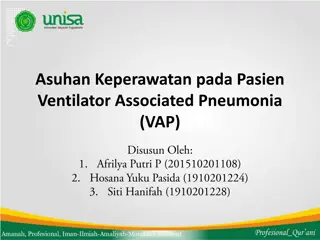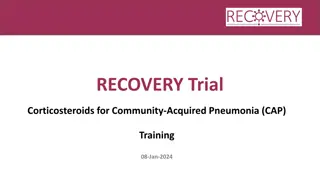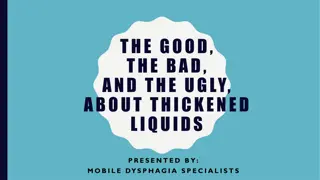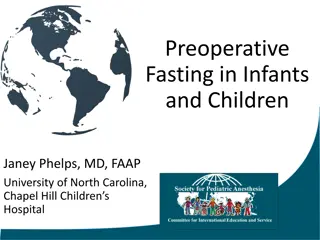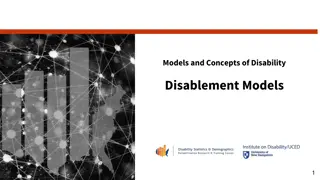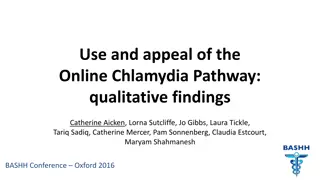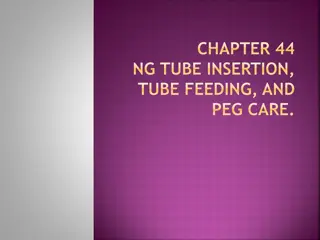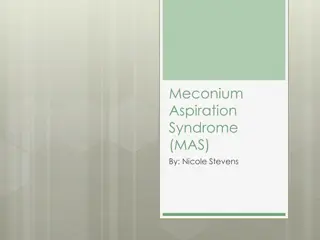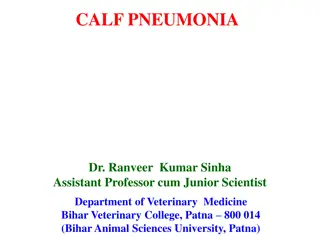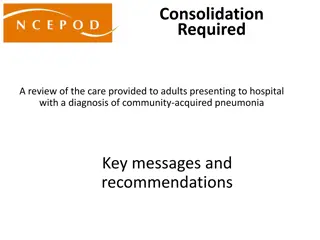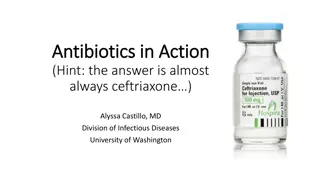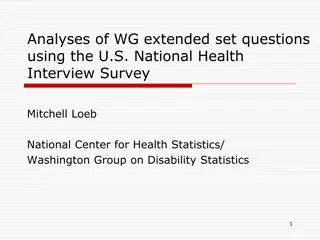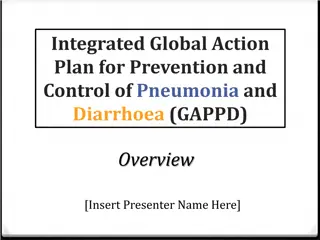Robert's Story: Learning Disability & Aspiration Pneumonia Care Pathway
Robert, a young man with cerebral palsy and a learning disability, undergoes a suboptimal care pathway for aspiration pneumonia. Follow his journey as his health deteriorates, highlighting the importance of optimal care in such scenarios to improve outcomes and quality of life for individuals with learning disabilities and associated health issues.
Download Presentation

Please find below an Image/Link to download the presentation.
The content on the website is provided AS IS for your information and personal use only. It may not be sold, licensed, or shared on other websites without obtaining consent from the author.If you encounter any issues during the download, it is possible that the publisher has removed the file from their server.
You are allowed to download the files provided on this website for personal or commercial use, subject to the condition that they are used lawfully. All files are the property of their respective owners.
The content on the website is provided AS IS for your information and personal use only. It may not be sold, licensed, or shared on other websites without obtaining consent from the author.
E N D
Presentation Transcript
RightCare learning disability and aspiration pneumonia scenario Robert s story: An implementation support tool that highlights the variation between optimal and suboptimal pathways Appendix 1: Summary slide pack Published: June 2023
Roberts story: This is the story of Robert s experience of a learning disability and aspiration pneumonia care pathway, and how it could be so much better. In this scenario we examine a learning disability and aspiration pneumonia care pathway, comparing a suboptimal but realistic scenario against an optimal pathway. At each stage we have modelled the costs of care, financially to the commissioner, and also the impact on the person and their family s outcomes and experience. 1 2 4 3 This document is intended to help commissioners and providers to understand the implications, both in terms of quality of life and cost, of shifting the care pathway. It shows how the RightCare methodology can help clinicians and commissioners to improve the value and outcomes of the care pathway.
Introducing Robert Robert is in his mid 20s and was born with cerebral palsy and a moderate learning disability. He has an older brother and younger sister, and lives in a residential college 10 miles from his parents. Robert is largely non-verbal. His family and his main carer, Lucy, understand his signing and he likes using a combination of vocalisations, Makaton, pictures and a specialist tablet computer to communicate. He uses a specialist wheelchair and is independent enough to use the bus with his carer. Although Robert doesn t like needles, he has had the pneumococcal, COVID-19, and flu vaccines which were offered when he attended his annual health check because he understood their benefits. With reasonable adjustments and lots of support from Lucy he tolerated the injections and knew that he could cope with injections and blood tests in the future, provided similar reasonable adjustments were made.
Robert and the suboptimal pathway The start of Robert s suboptimal journey: Robert is 20 years old Robert attended the local GP surgery for his annual health check. Lucy noted he had missed his last two dental appointments due to distress. Returning to college, he once again started to cough and experienced a stomach ache after eating. He had previously seen the GP for chest and stomach problems, with antibiotics usually prescribed. Day 1: Robert becomes ill and his symptoms deteriorate Lucy noticed that Robert kept coughing, was running a temperature, and refused food and drink. Robert deteriorated throughout the evening and his pulse oximeter reading dropped to 92%. In the morning, Lucy called the GP to arrange a home visit. The surgery did not appreciate how unwell Robert was and consequently did not attend. They suspected a chest infection and prescribed a course of amoxicillin capsules which Robert had trouble swallowing. Later that night, Robert went to hospital via ambulance due to a rattling in his chest. He became increasingly distressed, resulting in a chest x-ray being abandoned and no blood gas analysis being obtained. Despite having his hospital passport, this was not referred to. Day 2: Robert is discharged Robert was discharged with oral antibiotics and feed thickeners. No follow-up plans were arranged. As Robert couldn t swallow the medication easily, several doses were missed. Despite this he started to feel better. The feed thickeners were not explained to the carers, resulting in Robert continuing to cough when drinking. Day 6: Robert s symptoms return and an ambulance is called The college called an ambulance after Robert s symptoms worsened. No-one was allowed to accompany him in the ambulance. The stress exacerbated Robert s condition causing him to further deteriorate during the ambulance journey. Robert waited in the ED for several hours as no pre-alert was made, as a result the learning disability liaison nurse was unavailable. As his communication needs were not understood, he remained unaware and frightened. No reasonable adjustments were made, adding to Robert s distress. After admission to a general ward he became withdrawn, which the medical team mistakenly interpreted as a sign of calmness. But Robert became increasingly upset, the medical team perceived his behaviour as challenging and misinterpreted his fear as a refusal of the IV antibiotics. His family and carers were not allowed to visit when clinical decisions and procedures were being made or undertaken. No fluid balance chart was commenced, his hydration was not considered. No referrals were made for speech and language therapy (SaLT) assessment, dietetics or occupational therapy. No Recommended Summary Plan for Emergency Care and Treatment (ReSPECT) conversation took place. Day 9: Robert has a witnessed aspiration and deteriorates further Robert started to refuse feeds after finding eating painful, causing him to lose weight very quickly. The inconsistent use of feed thickeners resulted in Robert having a witnessed aspiration. These problems were exacerbated by poor posture as he still didn t have his wheelchair. He still hadn t received any IV antibiotics due to his distress at having the cannula inserted and continued to take them orally. The respiratory team were reluctant to refer him to critical care until Robert s mother and Lucy intervened, a phone consultation with the critical care consultant led to the conclusion that critical care would be inappropriate. Robert was moved to the respiratory ward three days later as he was critically ill. The staff decided to not resuscitate Robert if his heart stopped, which was not discussed with his family. He was referred to the palliative care pathway and died shortly after following a respiratory and cardiac arrest. Robert s family were devasted and lodged a complaint with the patient advice and liaison service (PALS).
Robert and the optimal pathway Robert s optimal journey starts much earlier. We go back four years to when he was 16 years old. Robert consistently attended his annual health check at his GP practice since he was 14 years old. The GP knows Robert well. Robert goes for a check-up at his local high street dentist twice a year who make the necessary reasonable adjustments for him. He nearly always sees the same dentist and hygienist. The staff at his college regularly undertake training sessions on identifying the symptoms of aspiration pneumonia and how to reduce the risks of developing it. Start of Robert s symptoms: Robert is 25 years old - GP review Robert deteriorated throughout the evening and his pulse oximeter reading dropped to 92%. In the morning, Lucy called the GP who visited Robert at college. Lucy used the SBARD communication tool to have a structured conversation with the GP. The GP arranged for an ambulance and explained to ambulance control that Robert had complex needs and had a hospital passport. Lucy was allowed to accompany Robert to the hospital. The ambulance crew phoned ahead to alert the hospital about Robert s condition and reasonable adjustments. The learning disability liaison nurse was informed of Robert s arrival and the medical team conducted a full ABCDE assessment. He was given IV and oral suspension antibiotics. Blood tests and a portable chest x-ray confirmed a pneumonia diagnosis. An urgent referral was placed to the SaLT team and Robert was transferred to the HDU following a phone assessment with the respiratory team. A ReSPECT conversation was held with Robert, Lucy and family to create a personalised set of recommendations for Robert s care in the case of an emergency situation. Day 2: Robert is admitted to critical care Robert is taken to critical care. After 24 hours of monitoring, Robert is discharged to a respiratory ward, with critical care outreach follow-up if needed. A personalised care plan is written. The hospital allowed Lucy and his family to be at the hospital for some of his treatments, they showed some of the staff on the ward how to communicate with Robert. Day 10: Robert is discharged from hospital with a clear plan Robert is discharged from hospital and he was advised, along with his parents and Lucy, on his recovery expectations and timescales were clearly explained. A detailed discharge summary was prepared and the discharge letter was electronically sent to Robert s GP and passed to the clinical pharmacist. 6-8 weeks later: Robert has a follow-up appointment and clinical review The acute learning disability liaison nurse informed the community learning disability teams of Robert s admission and discharge. Prior to discharge, Robert s medical team arranged for him to have a follow-up chest x-ray and clinical review by the respiratory team in 6-8 weeks time. A week before the appointment, the hospital phoned Lucy and Robert to discuss the appointment and reasonable adjustments, the learning disability liaison nurse arranged to attend the follow-up appointment to support Robert. The x-ray confirmed that the pneumonia had cleared up. The learning disability liaison nurse made the necessary follow-ups in the community by notifying the right teams to ensure that the right information was shared at the right time. On discharge, Robert returned to the residential college and, supported by Lucy and the community team, continued with his recovery with a care plan in place to prevent further aspiration.
Key themes of optimal care Use of soft sign skills and SBARD Personalised care and dignity Diagnostic overshadowing People with a learning disability who are becoming unwell may be unable to tell carers how they feel. In addition, symptoms may present differently. Soft signs are changes in a person s normal behaviour which could include changes in sleeping, eating, drinking and mood. It is important to recognise these signs as early identification of deterioration allows for early intervention and treatment. Personalised care planning is necessary to ensure people with a learning disability are supported to make the lifestyle and behaviour changes needed to achieve and sustain improvements in their physical health. Diagnostic overshadowing occurs when people assume that the behaviour, symptoms or signs of a person with a learning disability is because of their learning disability and they fail to consider whether other factors are causing this. For example, they may be in pain or have a physical health condition. Personalised care planning should address the full needs of the service user, taking steps to combat loneliness and isolation, and promoting wider engagement in selfcare, exercise, healthy eating and lifestyle. Crucially, the process involves shared decision-making between the service user and the professionals supporting them. Diagnostic overshadowing could result in key diagnoses being missed, potentially with serious consequences. There are tools such as SBARD (situation, background, assessment, recommendation and decision) which can be used by carers and health professionals to spot the soft signs of deterioration and provides a framework for communicating important and relevant information.
Key themes of optimal care Advance care planning and DNACPR Reasonable adjustments BTS pneumonia statements Advance care planning is a way for someone to express and document their preferences about how they wish to be cared for as their illness progresses. Advance care plans should be followed if someone loses mental capacity to make decisions about their care. Health and social care professionals should be ready to talk to people about their wishes and support them to make an advance care plan. The Equality Act 2010 and the Public Sector Equality Duty require that all publicly funded services make reasonable adjustments to remove any barriers physical or otherwise that could make it difficult for disabled people to use their services or prevent them from using them altogether , this is a legal requirement. The British Thoracic Society (BTS) statements provide pragmatic guidance on the management of certain clinical conditions. The recommendations made are based on a review of the published evidence but are predominantly based on expert opinion aimed at providing pragmatic guidance. This should include decisions about DNACPR do not attempt cardiopulmonary resuscitation. A DNACPR (or a DNR or a DNAR ) is an advance decision not to attempt cardiopulmonary resuscitation should a person experience cardiac or respiratory arrest. When used appropriately it helps to ensure that a patient s death is as peaceful and dignified as possible. Any decisions made must be with the appropriate involvement of the patient, their relatives or carers. Reasonable adjustments for someone with a learning disability or who is autistic could include longer appointments, providing easy read materials or having the support of a carer. They will vary from person to person. There are two that provide advice on aspiration pneumonia and learning disability: 1. The risk assessment, prevention and management of community-acquired pneumonia (CAP) in people with a learning disability. For people with a learning disability, it is evident that sometimes the complex combination of clinical circumstances and a lack of patient, or family and carer, involvement leads to the inappropriate issue of a DNACPR order. Remember that there will be patients over 18 who have a Health and Welfare Lasting Power of Attorney or a Deputyship in place. 2. Risk assessment, prevention and management of aspiration pneumonia (AP).
Financial information As Robert spends a similar total amount of time in hospital in both the suboptimal and optimal journeys the difference in cost is minimal, however, the outcomes for Robert could not be starker or more impactful. Sector Primary care Secondary care Ambulance service Community pharmacy Medicines Total Optimal ( ) 36 3,962 357 0 96 4,451 Suboptimal ( ) 48 3,698 714 0 39 4,499 The above table summarises the financial costs calculated for the two pathways by health sector/area. National average costs and similar data sources have been used to calculate the indicative healthcare costs of two hypothetical pathways of care for an individual fictionalised typical person, and therefore do not represent the local cost of service provision. It is recommended that systems work with local clinical leaders and costing colleagues to map existing pathways, taking into account local circumstances and evidence, and reflecting the make-up of the local population and services already in place.
Areas for systems to consider Below are some of the questions featured in the scenario. They are to support discussion and investigation within local systems and are focused on the key optimal themes that can lead to improvement in the treatment of aspiration pneumonia for someone with a learning disability: How does your local system assure itself that care is continually improved for people with a learning disability? 1 How do you ensure that all healthcare staff are sufficiently trained and made aware of diagnostic overshadowing and are able to identify soft signs of deterioration when treating people with a learning disability? 2 How do you assure yourselves that all reasonable adjustments are made available throughout the pneumonia care pathway for people with a learning disability? 3 How do you assure yourselves that there is a culture of personalised care and dignity embedded throughout your system or service? Who has responsibility for this? 4 How do you assure yourselves that appropriate advanced care planning conversations are routinely discussed with patients with a learning disability and their carers, including DNACPR (do not attempt cardiopulmonary resuscitation)? 5 How do you ensure your teams are prepared to offer treatment to someone with high support needs? 6 How do you assure yourselves that you ask, listen to and involve family and carers at all times (when it is appropriate to do so)? 7
Further information For more information about Robert s journey or RightCare: rightcare@nhs.net www.england.nhs.uk/rightcare www.future.nhs.uk/NationalRightCare @NHSRightCare Click here for the full scenario
